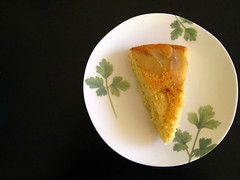A slice of cake for you, dear reader, in honor of an open cupboard‘s second birthday.
Two years ago today I posted an ironic ode to the high cost of organic food in the form of a silly riff on a famous poem by Robert Frost. Nothing much has changed since then. The price of rice has spawned riots and my relatives tease me for spending seven dollars on an occasional bottle of organic milk (but it’s from grassfed cows who listen to classical music and read poems by Robert Frost!). I’m still fascinated by the San Francisco local, organic food scene with its bounty of decently produced high quality food—the freshest, most beautiful, delicious vegetables and fruit it has been my pleasure to consume.
I owe the farmers’ markets my gratitude for opening up my taste buds to the earthy sweetness of heirloom tomatoes. Having eaten store-bought hothouse tomatoes back when I lived in Israel, I never much liked the fruit, except the exceptionally fresh ones I used to buy at the shuk (open market) . Similarly, bell peppers were a sort of tasteless filler in stir fries until I tried the peppers grown by Happy Quail Farms. I’ve also discovered foods that have quickly become my favorites: pimientos de padrón, stinging nettles, chocolate mint, mountain spinach. Thank the gods for all the dedicated farmers who produce such excellent food that is so much fun to eat.
I only wish that more people could enjoy the beautiful bounty of the farmers’ markets. Most of the consumers I see at the various farmers’ markets near my home tend to be middle class and upper middle class Americans. On occasion, I’ll see a poor student buy a few dollars’ worth of vegetables.
True, programs such as the Chez Panisse Foundation’s Edible Schoolyard and the People’s Grocery do a lot to bring people closer to good, sustainably raised food. But there are still so many others who simply cannot afford to eat well. In an area where average families drive two SUVs and live in half-million dollar homes, this boggles the mind.
In the coming months the gulf between those who eat well and those who cannot will swell, affecting many middle income as well as lower income people. The question is, what are we going to do about it? As “we” is usually an elected official (insert quip about political ineptitude here), let us instead ask ourselves “what am I going to do about it?” If every one of us asked ourselves that question, maybe we could get closer to an answer. Wouldn’t that be great? And what will our collective cupboard look like in another two years?
Thank you for your curiosity, and your stick-to-itiveness for coming back here even when I was slow to post. Thank you for putting up with my sometimes bumbling photos and the occasional silly lark. Thank you for spurring me on (even if you didn’t know you did). An extra special thank you to my friend Sylvia, for urging me to write about food in the first place (and to Jerry, for having such an insatiable appetite for dining out). And to my husband A for reading and eating and, when prompted, providing honest constructive criticism.
L’chaim! To another two years!
– shelly –

